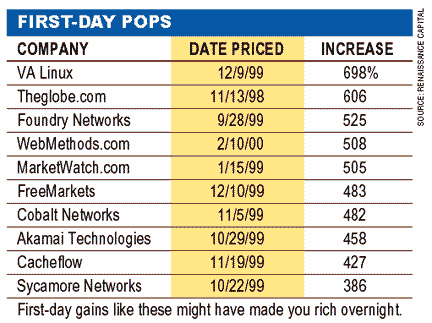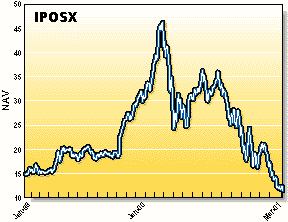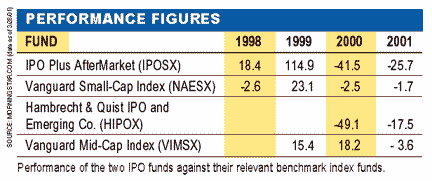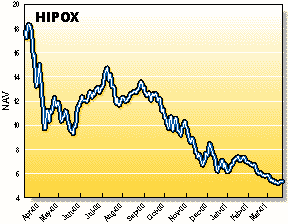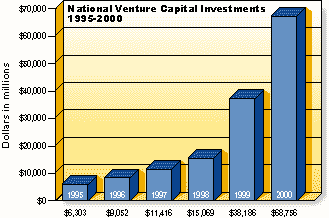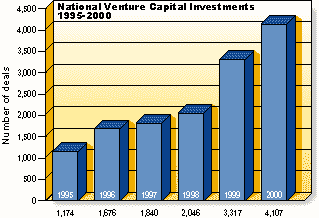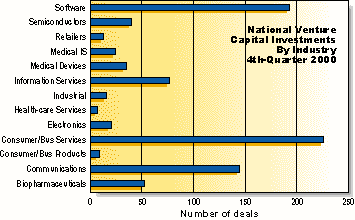
HOT TOPICS LIST
- Strategies
- Stocks
- Buy
- Investing
- Brokers
- Psychology
- Interviews
- Accumulate
- Sell
- Hold
- Spotlight
- Websites
- Candlestick Corner
- Gold & Metals
- Options Trading
LIST OF TOPICS
MUTUAL FUNDS
Get In The Game: Invest In IPOs
04/30/01 05:37:29 PM PSTby Sean Moore
IPOs are usually reserved for institutions and high-net-worth individuals. But by investing in IPO funds, you - yes, you! - can also get a piece of the action.
| During the great IPO frenzy of 1998-2000, stocks such as VA Linux, Foundry Networks, theglobe.com, and Akamai Technologies attracted enough attention to achieve gains in excess of 400% on their first day of trading. Those investors who were fortunate enough to acquire shares at the price at which they were initially offered to the public (IPO, please remember, stands for "initial public offering") would have made a bundle by selling those shares on the first day of trading. Yet investing in companies before they're offered to the public is impossible for most investors. Unfortunately, acquiring IPOs at their offering price is reserved for institutional investors and high-net-worth individuals; it seems unfair that individual investors do not get the opportunity to participate. Recognizing the need to fill this gap, Kathleen Smith, William Smith, and Linda Killian of Renaissance Capital started the IPO Plus Aftermarket Fund (IPOSX).
The IPO Plus fund is in the small-cap growth category and is relatively small, with assets totaling $45 million. In 1998 and 1999, it outperformed the Vanguard Small-Cap Index Fund (NAESX), but in 2000 through February 2001 the IPO Plus fund significantly underperformed that benchmark index fund. Due to the volatility of the IPO market, investing in a fund that focuses on IPOs can be risky. Not only that, but expenses are high. The expense ratio of the IPO Plus fund is 2.50%, compared to only 0.25% for the Vanguard Small-Cap Index Fund. Further, according to Killian, the average holding period of a stock is six months. This makes the turnover high, which in turn means higher capital-gains taxes. Face it, you are looking at something that is expensive and risky. So why invest in it at all?
The IPO Plus Aftermarket Fund has seen the best and worst of times.
"We think that nearly everyone should have a small portion of their portfolio in high-risk areas where the market has the potential for above-average returns," explains Killian. "The IPO market is really an inefficient market, and we feel that is where the potential for above-average returns lies." The sharp drop in the general markets, especially the technology sector, has resulted in hard times for the IPO market. A significant portion of the IPO Plus fund is invested in technology stocks, but recently, it has placed more weight in other sectors. The top holdings of the fund include biotech companies such as Invitrogen (IVGN) and Genentech (DNA), as well as AT&T Wireless (AWE) and Capstone Turbine (CPST). So how do IPO funds pick their holdings? IT'S ALL IN THE RESEARCH Renaissance Capital was the first company to conduct extensive research on the IPO market. That background has made research an important factor in the stock selection process of the IPO Plus fund. The thoroughness of the company's research can be seen in a recently published book, IPOs For Everyone. Renaissance Capital's research team studies thousands of companies. "We look at fundamentals, management control issues, valuation, and the group momentum of similar public companies," says Killian. Fundamentals include barriers to entry, a company's capital spending requirements, and technology. The major factor in determining the success of a company is the quality of the management team. When it comes to management, it is best to determine if a team has a record of success and good judgment, if the members own enough shares, and if they devote full time to the company.
One of the most challenging tasks is valuing a new company. The managers of the IPO Plus fund focus on: "We try to determine if the company is going to be a leader, the opportunities it faces, and if management has the potential to take the company where it wants to go," Killian explains. THE CYCLICAL IPO MARKET In spite of the weak IPO performance in the latter part of 2000 and early 2001, IPOs are still worth considering. At least that's what Linda Killian believes. "We are going to see a turnaround sooner or later. The lack of consumer confidence and fears of recession are not going to stop companies from innovating," she says. "The IPO market is cyclical in nature. You can see one particular industry develop with several IPOs entering the market, but then it very quickly dries up. This is actually typical in the IPO market. We saw it with the biotechs, then the gaming industry, then retailing, and now the e-tailing industry, business-to-business (B2B), business-to-consumer (B2C), and Internet." The volatility of the IPO market is typical; the market turns quickly. Thus, it's best to get in early. Killian believes that a new cycle will start sooner than later. Is it going to be the Internet sector next time? Killian predicts that the next IPO wave will be companies that spin off from older, established corporations, adding that she also believes we will see oil and energy stocks enter the IPO market in the near future. CONCLUSION So if you want to invest in these newly formed companies that have shown promising returns, an ideal way to do so would be to invest in an IPO fund. Unfortunately, you don't have too many choices. Although many mutual funds do invest in IPOs, only two focus on IPOs, the IPO Plus fund and the Hambrecht & Quist IPO and Emerging Company Fund (HIPOX). Both move in tune with the peaks and troughs that are typical of IPO markets, and this cycle will continue. Success is a matter of recognizing the beginning of the next boom and getting in early.
Hambrecht & Quist IPO and Emerging Company Fund started
Sean Moore can be reached at SMoore@Traders.com. Editor Jayanthi Gopalakrishnan can be reached at Jayanthi@Traders.com. SUGGESTED READING Killian, Linda, Kathleen Smith, and William Smith [2001]. IPOs For Everyone, John Wiley & Sons.
Investing
RISK IS THEIR GAME Before the institutional investors, before the initial public offering, venture capitalists are the financial lifeblood for many fledgling companies. HereOs a peek at what they do. Economic eras go through booms and busts, each with its unique certainties and problems. The correlation between a booming economy and innovation N the driving force behind an economy N is evident, but letOs not forget those responsible for making that innovation a reality: the venture capitalists. Venture capitalists provide entrepreneurs with the wherewithal to finance their projects and create the potential for wealth and profits. But their role doesnOt stop there. Beyond financing, they guide the companies and help them attain their goals. Venture capitalists are the catalysts for innovation; if it werenOt for them, we wouldnOt have as much innovation as we do. And without innovation, we wouldnOt have the boom and bust characteristic of an economy.
Being a venture capitalist involves extreme personal risk, but thatOs what it takes to make things happen. Without high risk, you canOt expect high returns. Although venture capital has been around since before World War II, it was only brought into the limelight during the dotcom era, when young companies promising rapid growth and significant economic contribution entered the stock markets. The dotcom era was significantly different from booming eras of the past. High risk was considered the norm in this era, not just among entrepreneurs or venture capitalists but also among investors. Individuals were willing to take the risk of working for newly formed companies, entrepreneurs were willing to take their firms public, and investors were willing to risk their hard-earned money to invest in them. In all, a substantial amount of high-risk capital was available. Although the dotcom era idolized and lionized venture capitalists, letOs not forget that they were in the business long before the emergence of the new economy, and theyOve seen more than the dotcoms come and go. THE VENTURE CAPITALIST Take Ed Goodman of Milestone Venture Partners, for instance. A veteran in the venture capital world, heOs seen it all. His interest in venture capital started in the mid-1980s, when he developed a respect for entrepreneurs. Goodman worked with British merchant bank Hambros Bank, where he was behind the funding of office-supplies chain Staples and the J. Peterman Co., made famous by the popular television show Seinfeld. After a few years, Goodman felt his personal interests in funding US%ADbased equities would be better served if he started his own firm. In 1999, together with fellow venture capitalist Todd Pietri, he founded Milestone Venture Partners. Currently, the firm has 13 investments and is moving forward to raise a seed fund. Goodman and Pietri focus on early-stage investments in business-to-business Internet-enabled companies in the New York metropolitan area. According to Goodman, the pre-Internet era and the Internet era have some obvious differences, but "historically, venture capitalists have a loving embrace between money and innovative technology," he says. And that hasn't disappeared; in 1999, there was a 20-fold increase from 1994 in the number of entrepreneurs stepping forward for funding, representing the cutting edge of innovation. "In the past, we had money embracing personal computers, semiconductors, and biotechnology," he points out. "Technology should cause structural change, and the Internet is the most illustrious example of this."
There's no doubt that the Internet has changed structures and distribution channels, created new markets and transformed old ones, and expanded opportunities. Goodman firmly believes that the Internet has been a more dramatic external force than PCs, biotechnology, or any other innovative technology. And since only a small percentage of the global population is on the Internet as of yet, this area still has a lot of potential to be explored. WHO GETS THE CASH? When a large influx of Internet-based companies are eager to get capital to start their companies, how does the venture capitalist decide which ones to invest in? When considering an investment, you can bet that venture capitalists do their due diligenceY and carefully screen each proposal for its technical and business merits, and as a result, only give money to a small portion of those who approach them. "Venture capitalists fund 1%AD2% of the opportunities that come to them," says Goodman. So you can imagine the amount of scrutiny they use to analyze a prospective company. How do they select the right ones? "Think of the process as an inverted pyramid, with the venture guys and investment bankers on the top. We get about 500 ideas per year and we automatically reject those that do not meet our exclusionary criteria. Approximately 10%AD15% get serious scrutiny," explains Goodman. A great deal of emphasis is placed on scrutinizing the management of the proposed venture. If the management shows potential, the venture capitalist will conduct a series of interviews with them before making a final commitment. A promising entrepreneur will be introduced to other venture capitalists, promoting the sharing of ideas and feedback with others, which can be invaluable. The entire process takes an average of two to four months, after which the venture capitalists commit funds and get the necessary security. They work with the company by helping to strengthen the management team and they also help with subsequent financing. Since Milestone Venture Partners is an early-stage financing company, they mainly finance the first round. However, they do attempt to get enough capital to bring the company to a positive cash flow N a challenging task. There are four levels in the funding process: 1. Bootstrapping (entrepreneurs coming up with the financing on their own) An early-stage financier prefers to get in at the first two levels. The goal of a venture capitalist is to invest in high-risk projects with the anticipation of high returns. The level of risk is no surprise, since most ventures financed through venture capitalists are in new areas such as information technology and biotechnology. Investing in a new area makes it difficult to anticipate future results, which certainly reduces the probability of success. It would be unrealistic to expect all financed companies to guarantee high returns. The venture capitalist should not be concerned about the failures, however. "When faced with failures, you have to decide where you are going to put your energy," comments Goodman. "You need to maximize your profits on your successful companies. A popular saying among venture capitalists is that we never try to make new mistakes. And with time, you will find a decline in the number of mistakes." WHAT DOES IT TAKE? The most important characteristics of a venture capitalist, according to Goodman, are luck and tenacity. "A successful venture capitalist should be able to step back and understand technology and markets. He or she should be able to understand the entrepreneur's vision as well as have a key vision of where things are heading, and most important, should have the courage to go in at an early stage," he says. Goodman has a word of advice for future venture capitalists: "Think carefully about your strategy, execute it, and be steadfast. Don't try to be all things to all people. Instead, have a clear focus." Finally, don't think that venture capitalists are taking a vacation just because the dotcom bubble has burst. They are still working as hard as ever and are on the lookout for new innovations. According to Goodman: "In 2000, approximately $70 billion was raised by venture capitalists N more than in any previous year. Although some of that money is supporting wounded portfolios, it will come back. It has to!" SUGGESTED READING Stross, Randall E. [2000]. eBoys, Crown Business.
Copyright © 2001 Technical Analysis, Inc. All rights reserved.
|
Traders.com Staff Writer.
| Title: | Project Engineer |
| Company: | Technical Analysis, Inc. |
| Address: | 4757 California Ave. SW |
| Seattle, WA 98116 | |
| Phone # for sales: | 206 938 0570 |
| Fax: | 206 938 1307 |
| Website: | www.traders.com |
| E-mail address: | smoore@traders.com |
Traders' Resource Links | |
| Charting the Stock Market: The Wyckoff Method -- Books | |
| Working-Money.com -- Online Trading Services | |
| Traders.com Advantage -- Online Trading Services | |
| Technical Analysis of Stocks & Commodities -- Publications and Newsletters | |
| Working Money, at Working-Money.com -- Publications and Newsletters | |
| Traders.com Advantage -- Publications and Newsletters | |
| Professional Traders Starter Kit -- Software | |
PRINT THIS ARTICLE

|

Request Information From Our Sponsors
- StockCharts.com, Inc.
- Candle Patterns
- Candlestick Charting Explained
- Intermarket Technical Analysis
- John Murphy on Chart Analysis
- John Murphy's Chart Pattern Recognition
- John Murphy's Market Message
- MurphyExplainsMarketAnalysis-Intermarket Analysis
- MurphyExplainsMarketAnalysis-Visual Analysis
- StockCharts.com
- Technical Analysis of the Financial Markets
- The Visual Investor
- VectorVest, Inc.
- Executive Premier Workshop
- One-Day Options Course
- OptionsPro
- Retirement Income Workshop
- Sure-Fire Trading Systems (VectorVest, Inc.)
- Trading as a Business Workshop
- VectorVest 7 EOD
- VectorVest 7 RealTime/IntraDay
- VectorVest AutoTester
- VectorVest Educational Services
- VectorVest OnLine
- VectorVest Options Analyzer
- VectorVest ProGraphics v6.0
- VectorVest ProTrader 7
- VectorVest RealTime Derby Tool
- VectorVest Simulator
- VectorVest Variator
- VectorVest Watchdog

